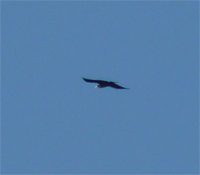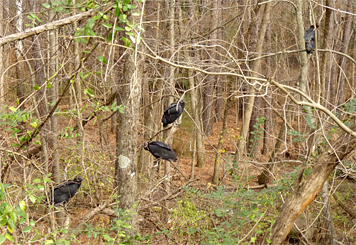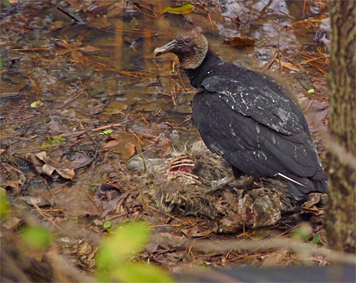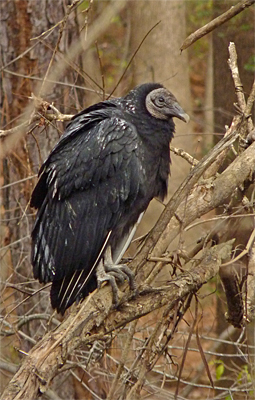As I stood on the Wetlands Overlook peeping through the viewfinder of my camera and waiting for a Yellow-rumped Warbler to magically appear on the Wax Myrtle nuts my camera was focused on, I heard the call of a Common Raven. I heard the call several times before I realized that it was indeed a raven. It was December 10th and I had heard what I thought was a Raven several days before, but discounted it when the calling ceased after only a few brief utterances.
Ravens are large birds, much larger than crows. I would compare their size to that of a Red-tailed Hawk, although their wings are not as broad as the hawk’s wings. Their call is distinctive, especially the croaking call. Listed as Very Rare in our area (Triangle), they’re being reported with increasing regularity. I’ve seen a raven on more than one occasion at Occoneechee Mountian Natural Area in Hillsborough, NC but not here in Durham.
Upon the realization that there was a raven nearby, I halted my futile attempt at photographing Butter-butts (Yellow-rumped Warblers) and went off to investigate. The call had come from the area between Catch the Wind and Explore the Wild, above the Lemur House. As I walked up the trail I saw, through the pines, a large black bird fly off in a southerly direction. The bird had the unmistakable wedge-shaped tail of a raven. I quickened my pace, I wanted a photo.
As I came up through Catch the Wind I saw the raven harassing a Turkey Vulture beyond the trees near the Traveling Seeds Exhibit. The bird was moving farther away from me. I moved faster.
Minutes (hours) passed before I again saw the raven, this time the bird was quickly moving towards the southwest and was some distance from where I stood. I managed to squeeze off two shots before it disappeared over the pines. Unfortunately, neither image is Pulitzer material, but they’ll have to do.

From the direction that the bird was heading it must have flown right over the main building of the Museum.
The following day I was alerted by a radio call from Joe Nucilli of the Facilities Department that there was a group of vultures hanging out near the swamp between Catch the Wind and Explore the Wild. I was on my way.
As I walked up to the scene, there were Turkey Vultures circling above and a small group of Black Vultures in the trees; there was something dead in the swamp.

Looking closer, I noticed one of the vultures next to a drain pipe which is close to the base of the dike that supports the trail. The bird was feeding on a carcass, a Raccoon.

Turkey Vultures often find a carcass, but it’s the Black Vultures that usually finish off the animal. Turkey Vultures have a highly development olfactory nerve (they can smell well) and it’s usually the smell that draws them in to a dead animal; the Black Vultures follow them in.
Vultures usually hang out in groups in search of carrion and perch together in trees at a kill site or at their night-time roosts. One of the hazards inherent in these large birds traveling and roosting in groups can be seen in the image below.

This was the same location that I had heard the raven calling from the day before. The raven that I saw had been harassing a Turkey Vulture. Was it a coincidence that I had seen the raven at this spot the day before, and that it had been chasing a vulture. Ravens eat carrion, are well know for scavenging whatever food they can find, and are often accused of being “mischievous.” I think it reasonable to suggest that the raven had been attracted to the activity around the raccoon, stopped in to investigate (or for a bite) and chased off a vulture or two when it left, just for spite. But I could be wrong.
I live in Washington State and I have ravens and wild turkey on my land. Throughout the day I toss corn out for the turkey and the raven sit in a tree and chatter then I toss dry cat kibble ( or table scraps) out for them. I greet them with HELLO and HI and I imitate some of their sounds pretty good ( they even left a painted rock for me). I see them competing for the same bit of food at times, and the turkey make it well known they dont want the raven near by and then the raven will hop and fly and land again and usually get the bit of food. My question is: Who is winning here? Did the turkey bully the raven away?…. or does the Raven think the turkey is a big ol dumb bird and playing head games with it?
I observe them daily and Im still not sure who is actually the alpha bird in this scene?
Thanks….
It sounds to me as though you’re all winning. The turkey and the raven get the food tossed out to them, with little effort on their part, and you get to witness the interaction between the two. Can’t beat that!
Enjoy.